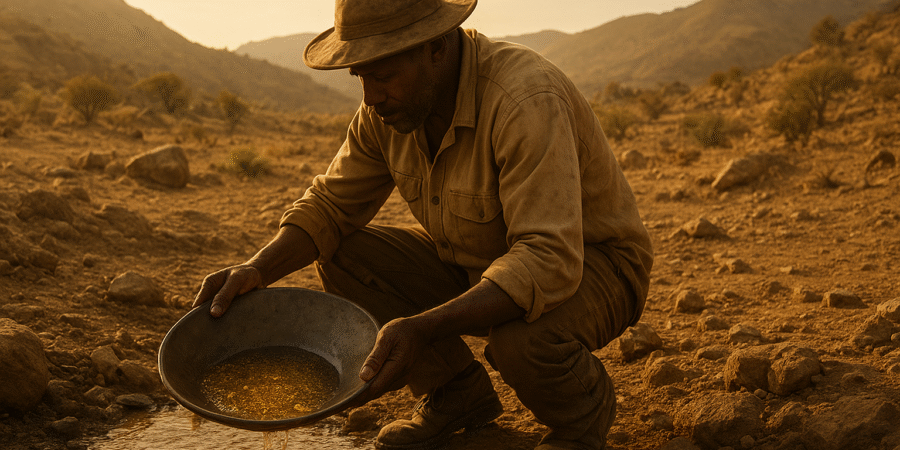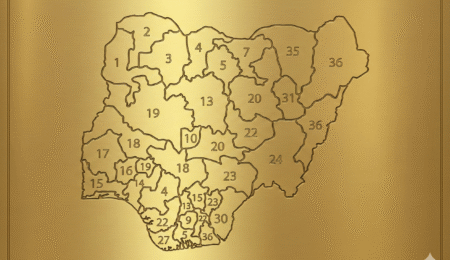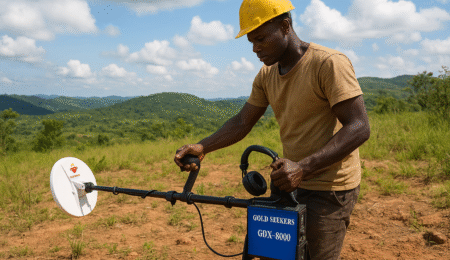Introduction
Zamfara State is not just another gold-bearing region in Nigeria; it is the undisputed heartbeat of the nation’s gold story, the place where geology, opportunity, and human ambition collide. For decades, people spoke about gold in Nigeria as rumor, myth, or bush-side speculation. But Zamfara changed everything. Here, gold is not theoretical; it is real, widespread, and in many places, barely hidden beneath the surface.
From farmland discoveries to riverbank nuggets accidentally uncovered during routine digging, Zamfara has become the state where ordinary soil turns into extraordinary possibility. And what makes this moment different from any time in history is simple:
Gold is being discovered almost daily — in new places, unexpected places, and places no one ever bothered to check.
This means one thing:
Every landowner, miner, cooperative, and exploration scout in Zamfara is now living in the middle of the biggest underexplored gold frontier in West Africa.
While some people are still waiting for “confirmation,” others are already scanning their grounds, identifying targets, and securing early advantages. In today’s mining landscape, fortune does not belong to the lucky — it belongs to the informed.
Zamfara is no longer a region of speculation. It is a gold-bearing ecosystem, and those who act now will define the next decade of mining success in Nigeria.
🟡 Thinking of exploring for gold in Zamfara? Whether you’re a miner, landowner, or investor, the GDX-8000 Gold Detector is the trusted tool transforming local gold discovery across Nigeria and West Africa.
Detect deeper, find faster, and uncover real opportunities beneath your land.
👉 Order your Original GDX-8000 NOW – exclusively from the Nigerian Mineral Exchange (NME), Nigeria’s leading mining marketplace.
💬 Chat directly with our support team on WhatsApp: +234 8130799304
Overview of Gold Geology in Zamfara
Zamfara lies firmly within the north-western branch of Nigeria’s Schist Belt system; a geological corridor known globally for hosting greenstone gold deposits. These belts are the same ancient rock systems that have produced multi-million-ounce gold mines in Ghana, Mali, and Burkina Faso.
In Zamfara, gold occurs in two primary forms:
1. Quartz-Vein Hard-Rock Gold
Found deep within:
- sheared schists
- altered greenstone units
- fractured basement rocks
These zones often produce high-grade veins, making them attractive for both artisanal and industrial mining.
2. Alluvial and Eluvial Gold
Accumulated in:
- river channels
- floodplains
- slope wash zones
These near-surface deposits are what make Zamfara a magnet for artisanal miners as the gold can be found without blasting or deep shafts.
But the most important geological insight is this:
Zamfara’s gold mineralization does not stop at known hotspots — it extends into underexplored and untouched lands.
This means:
- farmland could be sitting on a vein
- a backyard could host surface nuggets
- cooperatives may be working only 10% of a larger system
- unexplored ground is now the biggest opportunity
The old belief that gold exists only in “famous locations” is gone. Today, Zamfara is a state of open possibility, and exploration is no longer optional; it is strategic.
3. Major Gold-Bearing Areas in Zamfara
Although gold is now emerging across multiple zones, several locations remain the core hotspots, attracting miners, scouts, and investors.
Anka
Known as the historic center of artisanal mining, Anka hosts:
- rich alluvial deposits
- multiple vein systems
- decades-old mining camps
Many sites here have never been properly mapped, meaning the next big discovery may still be untouched.
Bukkuyum
Bukkuyum is where quiet discoveries keep turning into loud surprises. Reports of:
- shallow gold nuggets
- rapidly spreading mining pits
- newly exposed quartz veins
are becoming more frequent. Miners describe it as “the place where the land keeps revealing itself.”
Maru
Maru is the site of Nigeria’s famous Duki mine; historically one of the richest deposit zones ever recorded in the country. The area hosts:
- high-grade vein clusters
- sulfide-associated gold
- potential extensions beyond known workings
Exploration scouts believe Maru is far from finished.
Malele
Malele remains one of Zamfara’s least exploited but highly promising zones. With emerging artisanal activity and untested geological structures, the area is considered a future hotspot for early movers.
Dansadau Belt
This is the crown jewel — a large mineralized corridor stretching across remote terrain. Mining cooperatives, boot-on-ground scouts, and quiet investors are already circling the region because:
Where you find belts, you find gold; and where belts remain unmapped, fortunes remain untouched.
The Dansadau Belt is not just a mining zone; it is an opportunity zone.

4. How to Find Gold in Zamfara
Finding gold in Zamfara does not require luck, it requires strategy. Here are the most effective methods used by successful landowners, prospectors, cooperatives, and field teams:
✅ 1. Follow Quartz and Iron-Stained Rocks
Gold is commonly associated with:
- white or milky quartz veins
- rusty, reddish-brown rocks
- fractured and weathered schists
Where quartz appears repeatedly, gold may be close.
✅ 2. Search Old or Abandoned Workings
In Zamfara:
- old pits
- collapsed shafts
- shallow trenches
often indicate previous discoveries and many were abandoned long before the ore body ended.
✅ 3. Scan River Channels and Dry Streams
Alluvial gold settles in:
- bends of rivers
- low-energy zones
- gravel beds
These are high-probability targets for easy wins.
✅ 4. Use Modern Gold Detectors
This is the game-changer.
Many of the new gold finds in Zamfara are happening not because the gold wasn’t there — but because nobody checked before.
Field teams report that:
detectors are now discovering nuggets in places people walked over for years without knowing what was beneath their feet.
In 2025 onwards, the question is no longer “Is there gold in Zamfara?”
The real question is:
“Who will check their land first — and who will regret checking last?”
5. Tools Needed for Prospecting
Whether you are a miner, landowner, cooperative, or exploration scout, the essential tools remain consistent:
- gold detector (primary tool)
- shovel and pickaxe
- gold pan for preliminary testing
- GPS and mapping app
- sample bags
- handheld magnet
- safety boots and gloves
But in Zamfara’s terrain, where mineralization can be deep, patchy, or masked by ironstone — one tool now determines success more than any other:
A detector capable of penetrating mineralized soil and identifying gold with precision.
Without it, prospecting is guesswork.
With it, prospecting becomes strategy.
6. Regulations & Safety
It is important to acknowledge that:
- mining requires proper licensing
- illegal mining exposes communities to risk
- security conditions vary by location
- cooperatives should operate formally
For safety:
- avoid isolated operations
- never work alone in remote belts
- use detectors responsibly
- avoid conflict zones
In Zamfara, opportunity must be pursued wisely.
7. Recommended Tool for Gold Prospectors
✅ Why the GDX-8000 Is Leading the New Gold Rush in Zamfara
The biggest shift happening right now is that serious prospectors are no longer digging blindly. They are scanning intelligently, and that is why the GDX-8000 is rapidly becoming the preferred tool across:
- artisanal mining teams
- cooperative groups
- exploration scouts
- private landowners
- mining investors
What sets it apart for Zamfara:
- optimized for highly mineralized soil
- detects both small flakes and deep nuggets
- stable performance in iron-rich terrain
- easy for beginners, powerful for professionals
In a state where new discoveries are happening almost daily, the GDX-8000 is not just a tool, it is a decision:
Check your land today, or let someone else discover what was always yours.
8. Environmental Considerations
Responsible exploration protects:
- farmland
- water sources
- future land value
- Community
Best practices include:
- minimal disturbance during testing
- avoid river pollution
- rehabilitate shallow pits
- coordinate within communities
Small-scale mining can be sustainable when planning replaces disorder.
🟡 Thinking of exploring for gold in Zamfara or anywhere in Nigeria? Whether you’re a miner, landowner, or investor, the GDX-8000 Gold Detector is the trusted tool transforming local gold discovery across Nigeria and West Africa.
Detect deeper, find faster, and uncover real opportunities beneath your land.
👉 Order your Original GDX-8000 NOW – exclusively from the Nigerian Mineral Exchange (NME), Nigeria’s leading mining marketplace.
💬 Chat directly with our support team on WhatsApp: +234 8130799304
9. FAQ
Q: Is there still undiscovered gold in Zamfara?
Yes — significant amounts. New finds are emerging in areas previously assumed barren.
Q: Can ordinary landowners check their land for gold?
Absolutely. Many recent discoveries came from non-miners who simply scanned their property.
Q: Are detectors really necessary?
In 2025, yes. Surface signs alone are no longer reliable — most successful finds now involve detectors.
Q: Which communities have the highest potential?
Anka, Bukkuyum, Maru, Malele, and the Dansadau Belt remain top zones, but new areas are emerging continuously.
Q: Is it too late to get involved?
No — this is still the beginning of Nigeria’s gold awakening.
Final Word
Zamfara is no longer just a chapter in Nigeria’s mining story, it is the starting point of a new gold era. The soil has not finished speaking, and the land has not finished revealing what it holds.
For miners, cooperatives, exploration teams, investors, and especially landowners, the message is clear:
The people who act now will control the future. Those who wait will watch others claim what was always beneath their feet.
For a full national overview of gold deposits and trends, read our anchor resource: Nigerian Gold: State-by-State Guide.

READ ALSO:
17 Gold-Rich States in Nigeria: A Comprehensive Guide
The Ultimate Guide to Starting a Mining Company in Nigeria
10 Smart Ways to Find Gold on Your Land in Nigeria
Need a Mining License or Mineral Trade Permit in Nigeria? Here’s How We Can Help





Leave a Reply